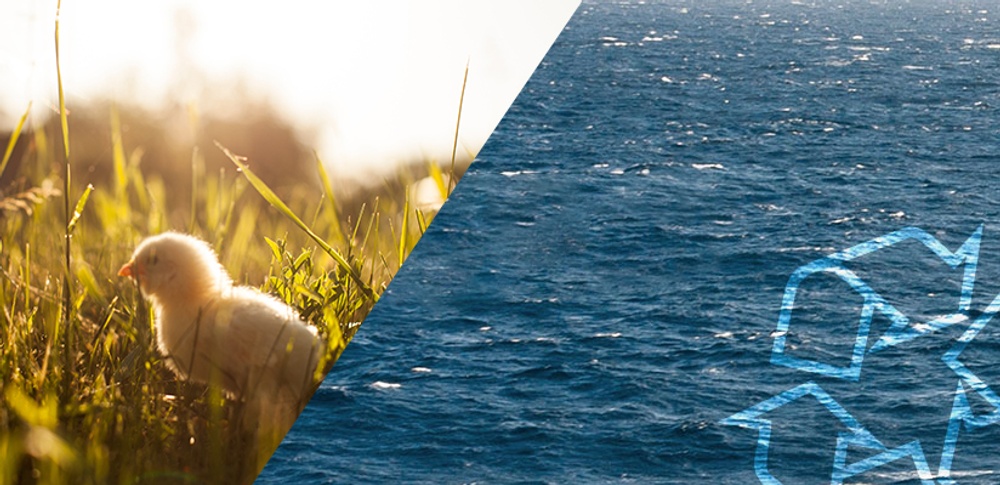Recycled phosphorus effective as a feed phosphate
 Recycled phosphorus effective as a feed phosphate. Photo: Michael Anfang
Recycled phosphorus effective as a feed phosphate. Photo: Michael Anfang A collaborative project to test the usage of recycled phosphorus produced by EasyMining’s Ash2Phos process has successfully shown that the phosphorus recovered from incinerated sewage sludge works as a feed phosphate for livestock.
– The results show that the trials worked, and for the first time it’s now possible for the market to have a recycled and sustainable feed phosphate with low climate impact, says Sara Stiernström, Product Manager at EasyMining.
The testing, which used digestibility studies of pigs and poultry to compare precipitated calcium phosphate (PCP) produced by EasyMining's Ash2Phos process with the commonly used monocalcium phosphate (MCP), is the first of its kind to demonstrate recovered phosphorus from sludge ash as a comparable source of the critical feed component.
Phosphorus is a key nutrient and an essential ingredient in the feed given to farm animals to ensures the healthy growth and development of livestock. But the primary raw material for feed phosphates is mined phosphorus, a finite resource. So, a new and innovative technology like the Ash2Phos process would offer a circular solution and a more sustainable source.
The joint venture launched at the start of 2021, with EasyMining providing the PCP, Lantmännen contributing co-funding and logistical assistance, and the Swedish University of Agricultural Sciences (SLU) handling all testing.
Two main studies, one for digestibility in pigs and one for broiler chickens, were conducted by SLU during the third and fourth quarters of 2021. Both compared feeds with PCP and MCP, measuring the amount of phosphorus in the “inputs and outputs” of the animals.
In both studies, growth for all animals was as expected and showed no noticeable difference on any of the diets. For the pigs, the estimated total tract apparent digestibility (TTAD) of phosphorus in the PCP was 60.4% and 83.8% of the phosphorus in MCP. For the chickens, the estimated ileal digestibility of phosphorus in the PCP was 58.4% and 75.1% of phosphorus in the MCP.
– The digestibility is important because if it's too low, it means that the animals don't absorb the nutrient, and it ends up in the manure, says Stiernström.
According to Stiernström, the testing also shows that the PCP has a digestibility that is slightly lower than MCP, but says it’s in the same range as other feed phosphates and that there are also additional parameters considered for feed phosphates, such as price, total environmental impact, CO2 emissions and use of the manure.
A full breakdown of the project and its findings will be presented during the Improving Sustainability of Livestock Production webinar, a free digital event organised by EasyMining, on February 3rd, 2022, at 13:00 CET. The webinar will also discuss the key issue of regulatory hindrances for recovered nutrients.
– This could actually be a great sustainable feed phosphate, but one of the things that’s problematic is the legislation, says Stiernström.
Today´s regulations throughout the European Union is designed to prevent contamination in animal feed that exclude the use of recovered nutrients, even if it fulfils all quality demands in the legislation.
– The most important next step will be to push for a new circular legislation that allows recovered phosphorus if it is effective and fulfils the quality demands. It is time to focus on quality, not origin, says Stiernström.
For more information, please contact:
Sara Stiernström, Product Manager at EasyMining, +46 (0)70 927 28 85, sara.stiernstrom@easymining.se
Emma Ranerfors, Press Officer, +46(0)10 723 24 16, press@ragnsells.com
WEBINAR: Improving sustainability of livestock production
An upcoming free webinar to present digestibility results on pig and poultry using a recovered feed phosphate and discuss the legislative hindrances for recovered nutrients.
When: February 3rd, 2022, 13:00 -14:30 CET.
FACTS: The process behind the Ash2Phos Feed project
EasyMining’s patented Ash2Phos process extracts phosphorus and other resources from incinerated sewage sludge. It can recover over 90% of the phosphorus in sewage sludge ash, which it also detoxifies and separates from heavy metals.
FACTS: The partners of the Ash2Phos Feed Project
The Swedish University of Agricultural Sciences (SLU)
SLU is an international university dedicated to research, education, and environmental assessment within the sciences for sustaining life. Its primary locations are in Alnarp, Umeå, and Uppsala, but it is also actively involved in research facilities, experimental parks, and other educational institutions throughout Sweden.
Lantmännen
Lantmännen is an agricultural cooperative and Northern Europe’s leader in agriculture, machinery, bioenergy, and food products. Founded on the knowledge and values acquired through generations of farmers, they make an effort to refine resources to make farming thrive. Their food brands include AXA, Bonjour, Kungsörnen, GoGreen, Vaasan, and more.
EasyMining
EasyMining is an innovation company dedicated to closing nutrient cycles. We are owned by the Swedish environmental company Ragn-Sells. We are passionate about inventing new technology that uses intelligent chemical solutions to close nutrient cycles. Our objective is to create new circular material flows in an efficient commercial way.
About EasyMining
EasyMining is an innovation company dedicated to closing nutrient cycles. We are owned by the Swedish environmental company Ragn-Sells. We are passionate about inventing new technology that uses intelligent chemical solutions to close nutrient cycles. Our objective is to create new circular material flows in an efficient commercial way.
